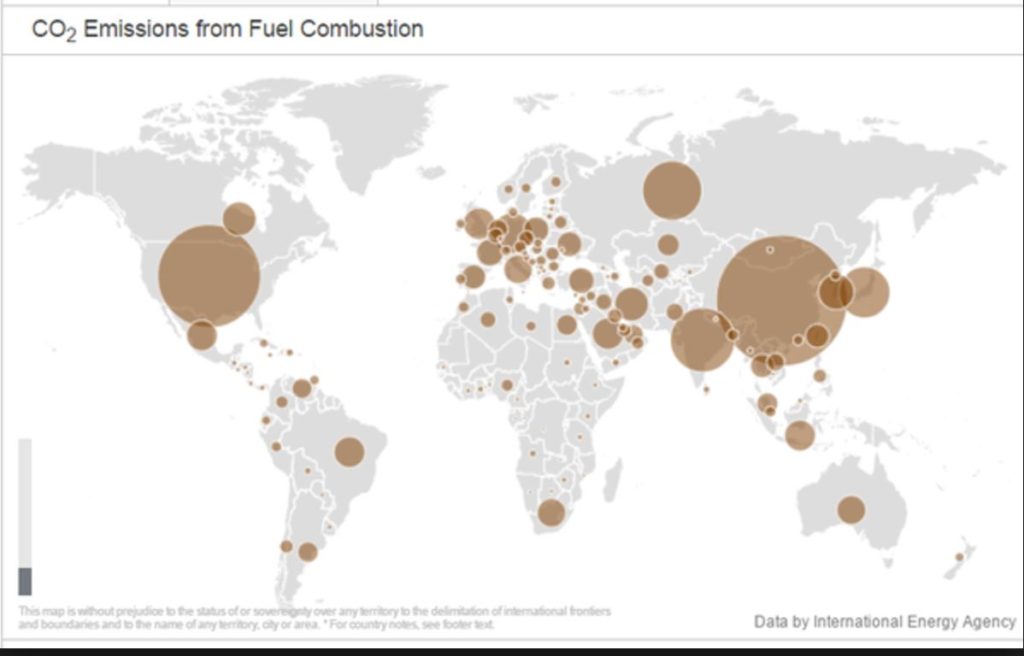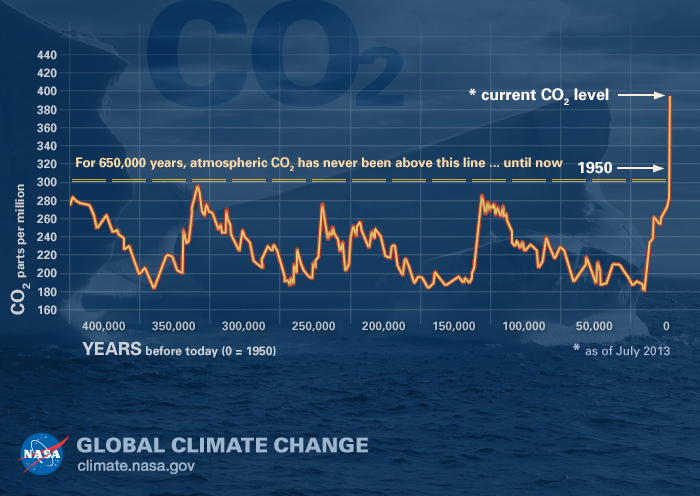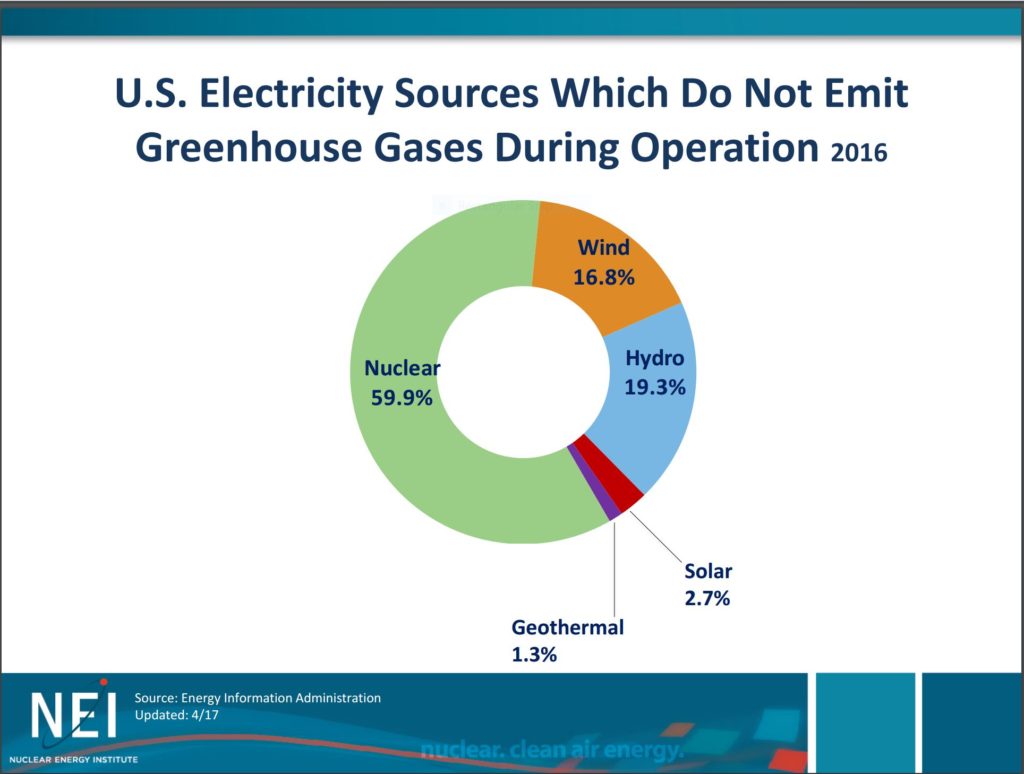In the last 10 years USA has reduced the carbon dioxide (CO2) by 13 % to the lowest annual level since 1992. During the same time China has become the world’s largest CO2 emitter by far, 28.2% of the global CO2 emissions (2016).

Global CO2 emissions from fossil fuel combustion. 2014. IEA Energy Atlas.
The primary driver for this substantial reduction of CO2 is economics. The shale gas revolution resulted in inexpensive natural gas. Natural gas fired combined cycle gas turbines (CCGTs) have become the lowest cost power generation and are replacing coal fired power plants. A state-of-the-art CCGT is almost twice as electric efficient than a traditional coal plant. So, when a coal plant is replaced by a new CCGT, in addition to the cost benefits the amount of emitted CO2 is cut nearly in half.
Global warming is broadly recognized as a fact. While the debate continues to what degree it is caused by natural events and by man, most people seem to agree that the anthropogenic (the man made) greenhouse gases (GHG) are significant enough to be meaningful to address and reduce. CO2 is not the only GHG, but it represents roughly 90 % of the GHG. (The other GHG can be “translated” to CO2 equivalents.) Consequently, much of the focus on GHG is on CO2.Scientists have concluded to stabilize the warming and keep global warming below 2° C above pre-industrial levels, it will be necessary to achieve stabilization of CO2 below 400 ppm. In 2013 CO2 breached the 400 ppm level and it looks like 2017 will exceed 410 ppm (parts per million), making the reductions efforts more urgent.

Atmospheric CO2 levels. NASA. Global Climate Change.
The United Nations Framework Convention on Climate Change (UNFCC) already in 1992 recognized that global warming is a global issue. The Kyoto Protocol, effective February 2005, was the first international treaty to commit developed nations to reduce GHG. Developing countries like China and India were not included on the rational that they were historically less responsible for the current levels of GHG. To make matters worse the United States never ratified the treaty and by 2012 Canada withdrew. Other countries like Japan and Russia did not take on new targets after the first commitment period ended 2012.
The Paris Agreement adopted 2015, signed by 195 UNFCC members and going in effect November 2016 tries to resolve some of issues with the Kyoto Protocol, not least trying to build a global consensus, including China and India. The Paris Agreement aims to hold the increase in the global temperature well below the 2° C. The contribution to GHG reductions should make are determined voluntarily by each country individually. The contributions shall be reported every five years and registered by the UNFCC Secretariat, but contrary to the Kyoto Protocol the Paris Agreement has no legal force. After each 5-year period, progressively more ambitious targets will be set. The first evaluation will be in 2023.
The Clean Power Plan (CPP), proposed by Environmental Protection Agency (EPA) in June 2014, was intended to be a major component in the US efforts to reduce CO2. The goal was to reduce CO2 from electric power generation by 32 % relative to 2005 levels within 25 years. CPP was halted by the Supreme Court in February last year. By an executive order in March this year (2017) President Trump directed EPA to review the CPP. Most likely CPP in its present form will be eliminated.
However, at the federal and state level there are several initiatives to reduce CO2 directly and indirectly. For example, there are federal tax credits to promote wind and solar, which have zero CO2. These tax credits will be phased out by 2020/2021.
29 states and District of Columbia have renewable portfolio standards (RPS). In addition, 8 states and 1 territory have renewable portfolio goals. The common denominator is to grow renewable energy, but specific targets and definitions are all different. The most aggressive RPS is Hawaii, which is set at 100 % renewables by 2045. California’s goal is 50 % by 2030. More typical are levels of 20 % renewable energy by 2020 -2025.

Renewable Portfolio Standard Policies. March 2015. DOE.
RPS are focused on sustainable renewable energy. It certainly will reduce CO2, but it leaves out other renewables such as “large hydro”, other zero CO2 emitters, such as nuclear, or the CO2 reductions by natural gas replacing coal, or better fuel efficiency by combined heat and power (CHP), etc.
Nuclear represents about 20 % of all power generation but 60% of all carbon free generation! Interestingly, while no recognition for existing nuclear, there is a 1.8 cents/kWh production tax credit for new nuclear for the first 6000 MW and first 8 years of operation. This tax credit was established in 2005 to support new nuclear. In comparison the production tax credit for new wind, established 1992, is 2.3 cents/kWh for the first 10 years of operation.

Nuclear Energy Institute. Based on data from EIA.
So, if the priority is to reduce CO2, the most straightforward way would be a carbon tax and allow markets to find the most economic solutions. As the Carbon Tax Center advocates a “robust tax on carbon pollution will create powerful incentives inducing policy-makers and individuals to reduce carbon emissions through conservation, substitution and innovation”. Additional arguments in favor of a carbon tax are transparency, predictability (carbon tax revenues), as well as replicability across borders.
In 1990 Finland became the first country with a carbon tax. The highest carbon tax presently is in Sweden, $131 per ton. As always, the devil is in the details. One conclusion is that the carbon tax must be set high enough to have an effect. In North America Quebec was first in 2007, followed by British Columbia in 2008. Canada recently announced a national carbon tax to start in 2018 at $7 (USD) and to be increased in annual steps to $35 (USD) in 2022.
A more radical carbon tax plan for United States was presented in February this year by Climate Leadership Council, “The Conservative Case for Carbon Dividends”. The plan suggests a starting point of $40 per ton and to gradually increase. The proceeds from the carbon tax should be distributed as a dividend to the citizens on an equal and monthly basis.
Focus so far has been on the electricity sector. In terms of GHG emissions it is according to EPA data (2015) the largest sector, 29%, and in relative terms the easiest to address. The second largest sector is transportation, 27%. So far CO2 reductions in this sector have been achieved by fuel efficiency standards and tax credits for electric and plug-in electric vehicles. However, to continue the decarbonization of the transportation sector vehicles will increasingly go electric, which makes additional sense to have a carbon tax and that way have a common ground for both the electricity and the transportation sectors.
An alternative to a carbon tax is cap and trade. Emission allocations are given to the emitters or auctioned and can be traded. The cap will gradually be reduced. Income from the allocations are assumed to be used to transition to no or low carbon technologies. The largest cap and trade program is the European Union Emission Trading Scheme, launched 2005. The results so far are not encouraging. In the first phase, 2005-2007, over-allocations given to the coal power plants resulted in windfall profits. The initial caps were too generous and price on carbon since 2008 dropped to $6 per ton. At such a low level, it does not have much of an impact. The three ruling European institutions (the Council, the Parliament and the Commission) have now entered negotiations for the cap and trade program 2021 to 2030. The most crucial question is if and how soon the surplus allocations, presently estimated to be 3 billion tons, will be eliminated or substantially reduced.
In summary, if GHG is the urgent challenge, then it should be the priority! A carbon tax should be an instrumental part of the means and measures to reduce GHG.